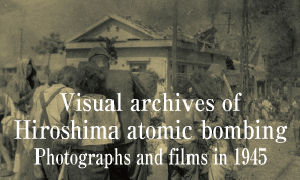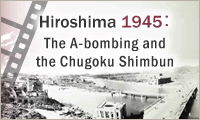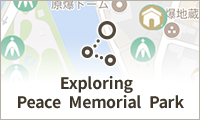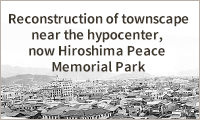Total of 388 people in former Zaimoku-cho confirmed to have died due to A-bombing by end of 1945, including numerous children and elderly
Apr. 28, 2000
On April 27, 2000, the Chugoku Shimbun compiled a report regarding the circumstances of the deaths from the Hiroshima atomic bombing of residents in the area of Zaimoku-cho (in the city’s present-day Nakajima-cho, Naka Ward), an area completely devastated by the bombing, based on cooperation received from bereaved family members. A total of 474 people in 154 households were confirmed to have lived in Zaimoku-cho as of August 6, 1945, the date of the atomic bombing. That day, 330 people, or 70 percent of the residents, were killed in the bombing, with another 19 people passing away by the end of 1945. Including residents participating in mobilized work from evacuation sites and those experiencing the bombing at relocation sites, 388 people had died in Zaimoku-cho by the end of 1945.
The Zaimoku-cho area stretched from where the Cenotaph for the A-bomb Victims is now located in Peace Memorial Park to present-day Peace Boulevard. Commercial shops and private homes stood around six temples in the area.
Based on materials left behind by Toshiaki Sakata, who died in 1989 and was one of the bereaved family members involved in a project from the late 1960s to the mid-1970s to recreate the hypocenter area and the Nakajima district, as well as records kept by the Hiroshima City government, the Chugoku Shimbun conducted a survey with support from around 300 bereaved family members living throughout Japan that the paper had searched for and identified starting in the summer of last year.
The age distribution of the 388 victims in the area who had died by the end of 1945 (ages of two people are unknown) shows that those aged younger than 10 years made up the largest group, at 77 people, followed by 61 people aged in their teens. One in three people were infants, small school children not yet eligible for schoolwide evacuation programs targeting students in third grade and above in elementary schools (national schools at the time), or boy and girl mobilized as student laborers or conscripted to work in the city. Combined with 82 victims at the age of 50 or older, about one in two people, or 57 percent of the victims, were children and people from that era’s elderly generation.
Of the 154 households confirmed to have been located in the area as of the atomic bombing, the largest number of deaths in a single household was eight people. Excluding single-person households, there were 20 households in which all members perished in the bombing with no family members to return from other places such as evacuation sites or the field of battle.
The oldest member of former residents of Zaimoku-cho was a 101-year-old woman who had lost her husband in the atomic bombing. Many of the residents who survived had left the center of the city at the time the atomic bomb was dropped for work, as mobilized workers, or to procure food. Most of those people left the area after the bombing. The few residents who had returned to the area were forced to relocate by the early 1950s to allow construction of Peace Memorial Park. In 1957, a stone monument engraved with the words “Remains of Zaimoku-cho” was erected by former residents on the east side of Peace Park’s plaza.
(Originally published on April 28, 2000)
The Zaimoku-cho area stretched from where the Cenotaph for the A-bomb Victims is now located in Peace Memorial Park to present-day Peace Boulevard. Commercial shops and private homes stood around six temples in the area.
Based on materials left behind by Toshiaki Sakata, who died in 1989 and was one of the bereaved family members involved in a project from the late 1960s to the mid-1970s to recreate the hypocenter area and the Nakajima district, as well as records kept by the Hiroshima City government, the Chugoku Shimbun conducted a survey with support from around 300 bereaved family members living throughout Japan that the paper had searched for and identified starting in the summer of last year.
The age distribution of the 388 victims in the area who had died by the end of 1945 (ages of two people are unknown) shows that those aged younger than 10 years made up the largest group, at 77 people, followed by 61 people aged in their teens. One in three people were infants, small school children not yet eligible for schoolwide evacuation programs targeting students in third grade and above in elementary schools (national schools at the time), or boy and girl mobilized as student laborers or conscripted to work in the city. Combined with 82 victims at the age of 50 or older, about one in two people, or 57 percent of the victims, were children and people from that era’s elderly generation.
Of the 154 households confirmed to have been located in the area as of the atomic bombing, the largest number of deaths in a single household was eight people. Excluding single-person households, there were 20 households in which all members perished in the bombing with no family members to return from other places such as evacuation sites or the field of battle.
The oldest member of former residents of Zaimoku-cho was a 101-year-old woman who had lost her husband in the atomic bombing. Many of the residents who survived had left the center of the city at the time the atomic bomb was dropped for work, as mobilized workers, or to procure food. Most of those people left the area after the bombing. The few residents who had returned to the area were forced to relocate by the early 1950s to allow construction of Peace Memorial Park. In 1957, a stone monument engraved with the words “Remains of Zaimoku-cho” was erected by former residents on the east side of Peace Park’s plaza.
(Originally published on April 28, 2000)






